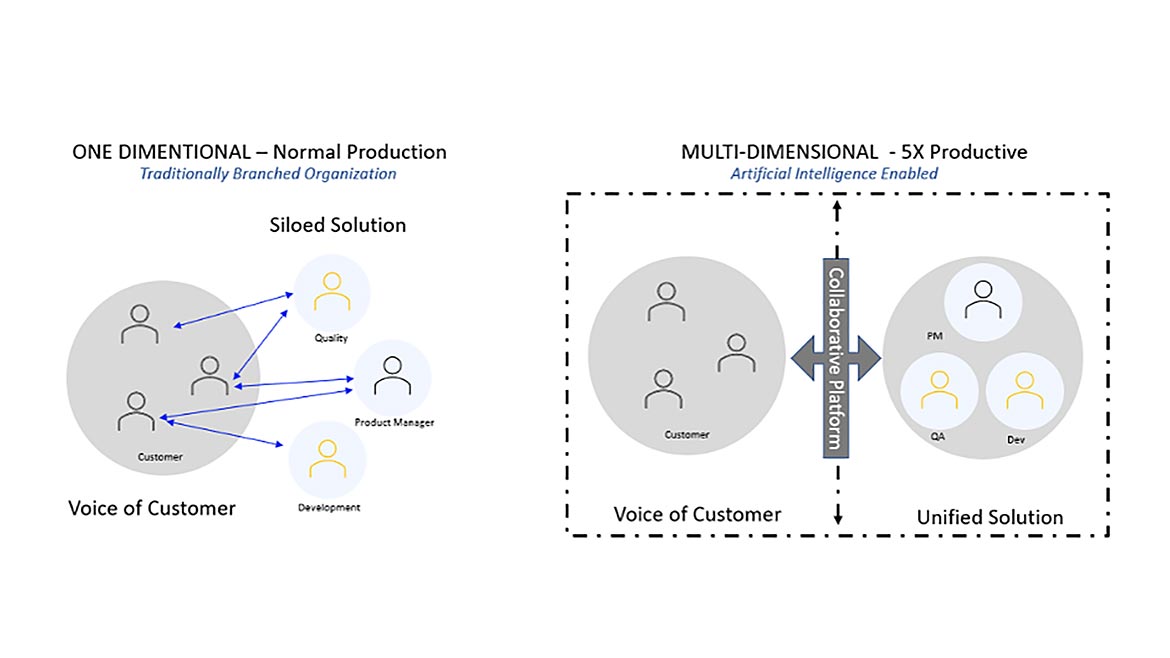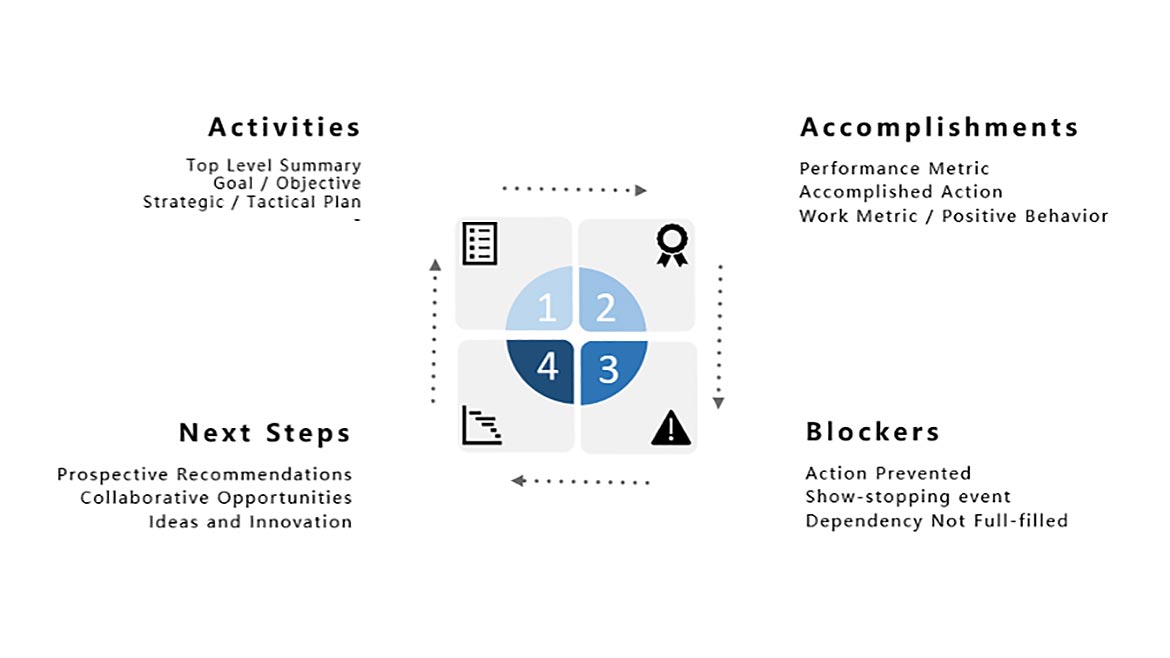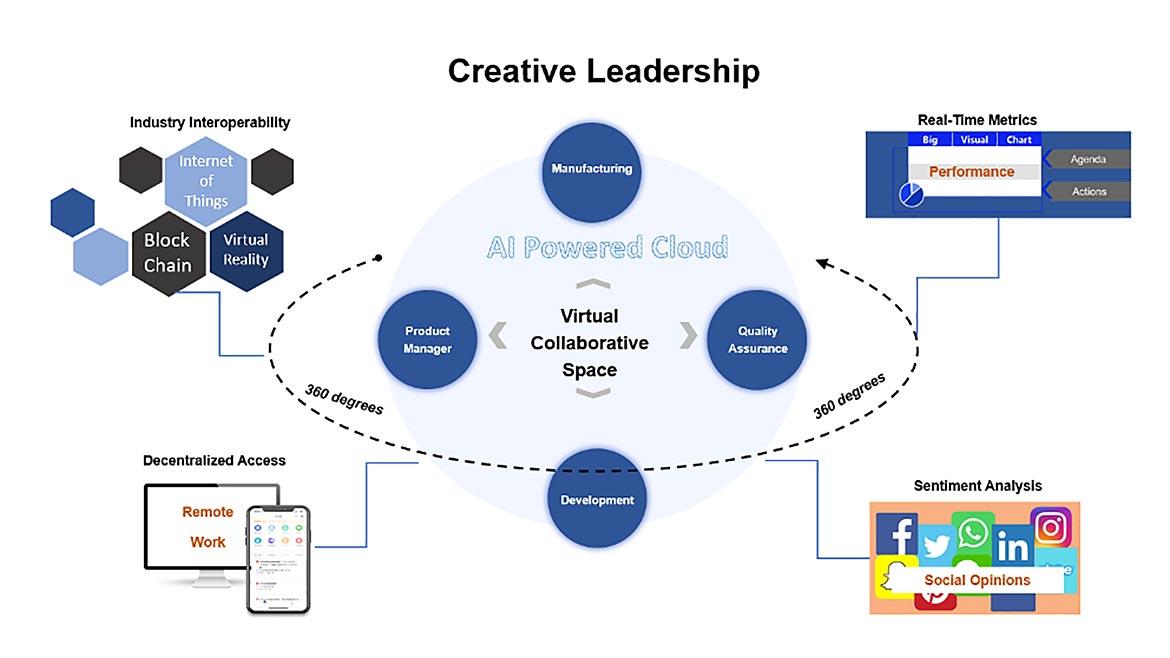Management
Activating Creative Leadership and Collaborative Teams
Tools for fostering synergy and cultivating collaboration at your company.

Image Source: solidcolours / iStock / Getty Images Plus
The pandemic has sparked a shift in many business models around the world, especially in the MedTech industry. The old manual labor model has sharply transitioned into businesses leaning on digitization and remote working models to cut costs, innovate, discover new drugs, enhance clinical trials, improve efficiency, boost productivity, and cut waste. Businesses quickly realized that shifting to a highly collaborative working model and relying on AI to reduce costs, stimulated new partnerships, and improved data driven decision-making and the speed of financial insights.
In this new landscape, companies are transitioning from the merger mentality to business partnerships instead with the goal of new drug discovery and medical innovations. Companies and regulators have also changed their business models to reflect a more cooperative and collaborative relationship, reducing barriers to meet urgent demands. This model is not going away anytime soon, in fact, it is the trend that is ushering in digital transformation.
Collaborative trends are on the rise in this post pandemic economy. Engineering teams are remote across the globe now. The era of digitized devices and artificial intelligence has allowed for creative talent to have flexible working arrangements. This ever-changing business model relies on creating remote-based collaboration strategies for businesses.
Businesses that don’t strategize around having their teams collaborate have higher failures in the workplace. “Only 9% of surveyed employees reported that their place of employment had very effective sharing and collaboration tools and systems in a Deloitte study. An additional 39% of respondents said that their company’s collaboration methods were somewhat effective.”1
Teams that collaborate perform 5X better than teams that don’t, yet it’s rarely invested in in business. “Collaborating on tasks and sharing ideas is valued at $1,660 per employee each year and the quality improvements made as a result of workplace collaboration are valued at $2,517 per employee each year. An international study performed by Deloitte found that workplace collaboration saves companies thousands of dollars per employee.”1
The introduction of AI-enabled applications has started to change the way we collaborate daily and has enhanced the way teams interact. Leading organizations are adopting strategies to integrate AI into teams to produce transformative business results. The old business model is one dimensional, where information flows from one individual to a group of siloed individuals or teams. In this case, organizations risk the loss of capturing vital customer requirements, feedback, and innovative opportunities due to isolated modalities. The new business model reflects a more multidimensional approach in sharing information between customers and businesses and ensures the customer's journey stays consistent through delivery and teams stay connected. The new model is the opposite of siloed, where organizations invest in collaborative tools and AI enhanced applications to unite everyone in the organization to the customer and to each other. One example that has recently hit the market is Zoom IQ. This artificial intelligence tool turns your meetings into “smart meetings” and provides insights and intelligent outcomes such as recording outcomes, facilitating meeting organization, and action item extraction.2 AI that runs on Microsoft Teams can assist in meeting productivity and personalization by way of keeping track of action items, summarizing meetings, and translating languages to reduce language barriers.3

Figure 1 – Old model vs new model Source: Maria DiBari and Alonso Diaz
The cultivation of a collaborative environment is essential and allows stakeholders to come together to share information, identify gaps, and develop solutions faster. This new model relies on fundamental transparency to see where individuals stand relative to their peers (see Figure 1). These collective mindsets can shift behaviors across organizations and can transform business outcomes.
The first step in cultivating collaboration.
Transform your Meetings to Drive Collaboration
Leadership must shift employee mindsets from a silo mentality toward adopting a collaborative attitude in the workspace. Staff meetings typically include each team member reciting a list of weekly tasks and priorities while the rest of the staff listen quietly. Often, hearing a long laundry list of tasks leaves people zoning out and feeling disconnected. These “task telling stories” are no value to businesses and drain company time. Staff walk away with very little interaction, and no one is really collaborating in this scenario. Meeting dynamics change when the behavior, and the mindset behind the behavior change. One way of accomplishing this is using the 4up communication model.
The 4up communication model is a big visual of four quadrants providing pertinent information around activities, accomplishments, blockers, and next steps and can be used as tool to foster collaboration immediately. The four quadrants promote awareness in other workflows to ensure that all members of the team understand job functions, daily tasks, departmental policies and procedures, and how their work impacts others on the team. This tool allows participation for teams to problem-solve collaboratively and visualize a common goal. This system ensures that everyone has the knowledge necessary to better interact with business units and visual information being presented.
The use of 4Ups encourages employees to take personal ownership of issues, including taking responsibility in participating in correcting them, helps stakeholders find points of entry into other workflows, aid in immediate mitigations for blockers, and collaborate as a non-hierarchical, synergistic team. The use of a 4up in operational standups or meetings elevate the most important information around workflows. This allows for immediate feedback during team discussions, coaching, and even performance management conversations.
Employees complete and present this visual template to effectively communicate their current activities to the rest of the team, ensuring impactful issues are highlighted. An effective way to use the 4up is by following Figure 2. The 4up requires individuals/teams to list Activities, Accomplishments, Blockers, and Next Steps following the arrow’s direction. Activities strategically and tactically align with high level goals and objectives of the company. This is followed by listing personal or team Accomplishments which highlights that important performance activity that helped accomplish the goals and objectives. This will spark conversations around positive behaviors that drive success. Blockers represent show stopping events or issues that need immediate attention or action. These can often represent a risk to the organization or an opportunity for improvement. Next Steps highlights the path forward on a workflow journey, calling attention to potential collaborative opportunities and ideas.

Figure 2 – 4Up Diagram Source: Maria DiBari and Alonso Diaz
Transforming company meetings to promote value, connectivity, conversation engagement and thought require a shift in mindset and an investment by leadership. Leaders can encourage a value add, collaborative staff meeting by using 4Ups to help teams shift from meetings focused on tasks to meetings focused on Activities, Accomplishments, Blockers and Next Steps.
Establish Collaborative Working Sessions
Many businesses suffer from siloed teams. Working solo, in a silo, will never win a game, but working as a team will. Breaking down silos means a free flow of information from one person or team to another person or team. Breaking down silos and seeing a noticeable change in team behavior can be affected by focusing on and promoting these areas.
Know what your colleagues do
Gaining a true understanding of the nature of what your colleagues and cross-functional teams do and why they do it, breaks down barriers and gives rise to opportunities. Use 4ups for an open forum discussion to spark conversations and questions about your colleague’s workflow. Having a few visual overviews of some of your work can also inspire curiosity. Images are emotional, influential, and memorable and help share concepts and achieve knowledge.
Embrace the mixed bag
Embracing diversified viewpoints, skill sets and knowledge bases will spark fresh ideas and solutions to old problems, transforming a stale dialogue into increasing reciprocity. Intentionally recruiting team members with different thinking styles, functional expertise, education, and personality accelerates performance and creativity in business. Diverse teams are simply smarter. One way to overcome stale ways of thinking and sharpen performance is to work with people who think differently than you and challenge old thinking styles.
Share incentives
Eliminating the internal monopolies of workload, knowledge, power, and spreading responsibilities and opportunities across functions drives participation and interest cross-functionally. Deliberately create a process that spreads responsibility across owners and business units. Creating a culture of winning and sharing the rewards together in organizations helps boost morale, drives employee loyalty and friendly competition.
Radical candor
Discourage hiding failures and viewpoints. Failures always lead to great sources of improvements and opportunities. Encourage speaking directly and caring deeply in meetings and one-on-ones. “Radical Candor: Be a Kick-Ass Boss Without Losing Your Humanity” is a business leadership book written by former Apple and Google executive Kim Malone Scott.4 In the book, Scott defines the term radical candor as feedback that incorporates both praise and criticism. Radical candor involves caring personally while challenging directly. Caring deeply means sharing real thoughts and constructive criticism with your colleagues because not sharing would be doing them a disservice. Open interactions in teams are the gateway for a flow of ideas and meaningful discussions. Use Radical Candor as a compass for candid conversations in business.
Build the talent
Deliberately employ innovators and idea generators who are collaborative. These employees will encourage free thinking among others, encourage new solutions to old problems, and embrace diverse ways of problem solving. Building a mindset of innovation in-house entails setting up rules around sharing freely, honestly and creating a space to do so. Comfort doesn’t spark innovation or change. Issues, organizational tensions, and problems are the driving force behind innovation and real change, coupled with employees that feel safe and empowered to disrupt the status quo.
Prioritize collaborative working sessions with colleagues to create a space of real-time exchanges for the purpose of problem solving, idea generation, learning and knowledge transfer. Often, virtual water cooler chats lead to newfound ideas and solutions because people are in a relaxed state and feel comfortable sharing. Creating a similar space, open forum, encourages idea generation and creativity which can consistently bring in a stream of ideas. Creating a collaborative working culture will not only drive innovation but will preserve talent.
“Most American workers rate collaboration as a key element for their career success. 48% of professional and technical employees, 54% of administrative employees, 57% of managers and directors, and 66% of senior and executive employees say that their job is reliant on in-person collaboration, according to a workplace survey by Gensler.’’ 1
Employees want a sense of connectedness with their teammates and company. Working, collaborative sessions promote this sense of team-ship and will promote productivity, open communication and constant flow of new ideas. “Companies that collaborate are 30% more innovative and at least 36% more productive than those that don’t, according to numbers released by Frost & Sullivan.” 1
Boldly Celebrate Success
When there is a win, talk about it, brag about it and shine a light on it.
Elucidate the winning behaviors in teams, on projects and around improvement accomplishments publicly and openly. Don’t gloss over wins, advertise them. Get people talking about wins, and mimicking positive behaviors that bring organizational successes.
Focusing on positive behaviors in teams highlights pathways of success. Companies can start celebrating success by reward systems such as LinkedIn announcements or employee spotlight articles, internal announcements, point systems, and president’s awards. It’s easy to focus on negative feedback and responding to issues in the business, but positive feedback, behavior that drive success and customer satisfaction need a brighter light. If something went well, everyone should know about it.
Having the collaborative edge means creating a culture that empowers our teams to speak up, work together, and take control of their department’s own quality.
Within a team, collaboration leads to better problem solving, knowledge transfer, shared purpose, and ideation. Collaboration plays a critical role between business units and success relies intimately on their ability to maintain collaborative relationships. The key features of successful collaborations between teams are the ability to illuminate unforeseen opportunities, create new value within disciplines, and overall team perspicacity.
Leverage collaborative artificial intelligence
Artificial intelligence is a quintessential tool in aiding our collaboration with colleagues, and this continues to grow. The branch of AI that is becoming a game changer in business is Natural Language Processing (NLP). NLP in software programs allow computers to process and analyze large amounts of natural language data coming from meeting conversations and activity, virtual meeting rooms and whiteboards. Sentiment analysis, key word extraction, and summarization are all examples of NLP methods. The use of these methods enhance our ability to understand team sentiment and context of discussion, key concepts, and can even extract insights from team interactions.
These AI applications are often add-ons within popular virtual meeting software or can be downloaded from software application marketplaces. Virtual bot assistants that are backed up with NLP capabilities are becoming common additions to industrial workflows and can provide a 360-degree approach in measuring and monitoring meeting outcomes, enriching meeting notes, and offering brand new perspectives. The use of AI in web-conferencing platforms enable virtual cloud collaboration on projects in real-time providing meeting lifecycle assistance with the ability to automate by note taking, recommend interactive learning of discussed topics, and sending automated action items to team members. This AI technology is empowering creative leadership in organizations. The 7 Best AI Meeting Assistant Apps You Should Use provides most used tools hitting the market.5

Figure 3 – Creative Leadership Source: Maria DiBari and Alonso Diaz
AI add-on applications will also play a role in hybrid workplaces, embracing the flexibility of staying connected with remote work, while increasing efficiency and productivity in workflows. Real-time engagement can be enabled in meetings that help recap calls, track talk time, engagement and sentiment scores, meeting reports, playbacks, action items, and recommendations for continuous improvement. These AI based algorithms will continuously learn actions and tasks and help sharpen team dynamics. AI and its interoperable capabilities in cloud computing are transforming workflows, meetings, and interactions creating fertile ground for collaboration and ideation. This new Creative leadership model (see Figure 3) will require a virtual collaborative culture geared toward the balance between innovation, quality, and AI.
References
- 35+ Compelling Workplace Collaboration Statistics [2023]: The Importance Of Teamwork - Zippia
- Evolving Zoom IQ, our AI smart companion, with new features and a collaboration with OpenAI | Zoom Blog
- Artificial Intelligence Solutions | Microsoft AI
- Radical Candor: Be a Kick-Ass Boss Without Losing Your Humanity, Kim M. Scott, March 2017
- The 7 Best AI Meeting Assistant Apps You Should Use (makeuseof.com)
Looking for a reprint of this article?
From high-res PDFs to custom plaques, order your copy today!





